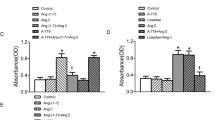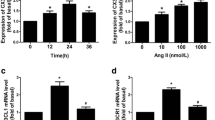Summary
Angiotensin II (ANGII) plays an important role in the pathogenesis of atherosclerosis by inducing proliferation of vascular smooth muscle cells (VSMCs). In our study, we observed the effects of valsartan on proliferation of cultured VSMCs treated with or without ANGII by cell counting and methyl thiazolyl tetrazolium (MTT) assay, and detected the expression of mitofusin 2 (Mfn2), a newly discovered cell proliferation inhibitor and a related cell proliferation signaling pathway protein by Western blotting. ANGII at a concentration of 10−6 mol/L significantly stimulated VSMCs proliferation, down-regulated the expression of Mfn2 and up-regulated the expression of Raf and ERK1/2. Valsartan inhibited such effects of ANGII at concentrations of 10−5 and 10−6 mol/L, but not at 10−7 mol/L. Valsartan had no significant effect on the proliferation of untreated VSMCs. These results suggest that valsartan inhibits ANGII-induced proliferation of VSMCs in vitro via Mfn2-Ras-Raf-ERK/MAPK signaling pathway.
Similar content being viewed by others
References
Braun-Dullaeus RC, Mann MJ, Dzau VJ. Cell cycle progression: new therapeutic target for vascular proliferative disease. Circulation, 1998,98(1):82–89
Roger VL, Go AS, Lloyd-Jones DM, et al. Heart disease and stroke statistics—2011 update: a report from the American Heart Association. Circulation, 2011, 123(4): e18–e209
Ross R. Atherosclerosis is an inflammatory disease. Am Heart J, 1999,138(5 Pt 2):S419–S420
Dzau VJ, Braun-Dullaeus RC, Sedding DG. Vascular proliferation and atherosclerosis: new perspectives and therapeutic strategies. Nat Med, 2002,8(11):1249–1256
Andrés V, Castro C. Antiproliferative strategies for the treatment of vascular proliferative disease. Curr Vasc Pharmacol, 2003,1(1):85–98
Charron T, Nili N, Strauss BH. The cell cycle: a critical therapeutic target to prevent vascular proliferative disease. Can J Cardiol, 2006,22(Suppl B):41B–55B
Brasier AR, Recinos A 3rd, Eledrisi MS. Vascular inflammation and the renin-angiotensin system. Arterioscler Thromb Vasc Biol, 2002,22(8):1257–1266
Vaughan DE. Angiotensin and vascular fibrinolytic balance. Am J Hypertens, 2002,15(1 Pt 2):3S–8S
Chen KH, Guo X, Ma D, et al. Dysregulation of HSG triggers vascular proliferative disorders. Nat Cell Biol, 2004,6(9):872–883
Eguchi S, Matsumoto T, Motley ED, et al. Identification of an essential signaling cascade for mitogen-activated protein kinase activation by angiotensin II in cultured rat vascular smooth muscle cells. Possible requirement of Gq-mediated p21ras activation coupled to a Ca2+/calmodulin-sensitive tyrosine kinase. J Biol Chem, 1996, 271(24):14 169–14 175
Chen KH, Wang F, Zhang J, et al. Cloning and expression of a novel partial cDNA related to hypertension. Chin Med J (Engl), 1998,111(4):383–384
Bach D, Pich S, Soriano FX, et al. Mitofusin-2 determines mitochondrial network architecture and mitochondrial metabolism. A novel regulatory mechanism altered in obesity. J Biol Chem, 2003,278(19):17 190–17 197
Guo XM, Chen KH, Guo YH, et al. Mitofusin 2 triggers vascular smooth muscle cell apoptosis via mitochondrial death pathway. Circ Res, 2007,101(11):1113–1122
Black HR, Bailey J, Zappe D, et al. Valsartan: more than a decade of experience. Drugs, 2009,69(17):2393–2414
Mueck AO, Seeger H, Lippert TH. Valsartan inhibits angiotensin II-stimulated proliferation of smooth muscle cells from human coronary artery. Int J Clin Pharmacol Ther, 1999,37(7):365–366
Kohno M, Ohmori K, Nozaki S, et al. Effects of valsartan on angiotensin II-induced migration of human coronary artery smooth muscle cells. Hypertens Res, 2000, 23(6):677–681
Chien KR, Hoshijima M. Unravelling Ras signals in cardiovascular disease. Nat Cell Biol, 2004, 6(9):807–808.
Wu L, Li Z, Zhang Y, et al. Adenovirus-expressed human hyperplasia suppressor gene induces apoptosis in cancer cells. Mol Cancer Ther, 2008,7(1):222–232
Zhou W, Chen KH, Cao W, et al. Mutation of the protein kinase A phosphorylation site influences the anti-prolifera tive activity of mitofusin 2. Atherosclerosis, 2010,211(1): 216–223
Bokemeyer D, Lindemann M, Kramer HJ. Regulation of mitogen-activated protein kinase phosphatase-1 in vascular smooth muscle cells. Hypertension, 1998,32(4):661–667
Keenan SM, Bellone C, Baldassare JJ. Cyclin-dependent kinase 2 nucleocytoplasmic translocation is regulated by extracellular regulated kinase. J Biol Chem, 2001,276(25): 22 404–22 409
Touyz RM, Schiffrin EL. Signal transduction mechanisms mediating the physiological and pathophysiological actions of angiotensin II in vascular smooth muscle cells. Pharmacol Rev, 2000,52(4):639–672
Ohtsu H, Suzuki H, Nakashima H, et al. Angiotensin II signal transduction through small GTP-binding proteins: mechanism and significance in vascular smooth muscle cells. Hypertension, 2006,48(4):534–540
Eguchi S, Numaguchi K, Iwasaki H, et al. Calcium-dependent epidermal growth factor receptor transactivation mediates the angiotensin II-induced mitogen-activated protein kinase activation in vascular smooth muscle cells. J Biol Chem, 1998,273(15):8890–8896
Feng TC, Ying WY, Hua RJ, et al. Effect of valsartan and captopril in rabbit carotid injury. Possible involvement of bradykinin in the antiproliferative action of the renin-angiotensin blockade. J Renin Angiotensin Aldosterone Syst, 2001,2(1):19–24
Yamamoto T, Sata M, Fukuda D, et al. The angiotensin II type 1 receptor blocker valsartan attenuates graft vasculopathy. Basic Res Cardiol, 2005,100(1):84–91
Author information
Authors and Affiliations
Corresponding author
Additional information
This study was supported by grants from the National Natural Science Foundation of China (No. 30872714 and No. 30971244).
Rights and permissions
About this article
Cite this article
Liao, H., Gong, J., Zhang, W. et al. Valsartan inhibits angiotensin II-induced proliferation of vascular smooth muscle cells via regulating the expression of mitofusin 2. J. Huazhong Univ. Sci. Technol. [Med. Sci.] 32, 31–35 (2012). https://doi.org/10.1007/s11596-012-0005-y
Received:
Published:
Issue Date:
DOI: https://doi.org/10.1007/s11596-012-0005-y




